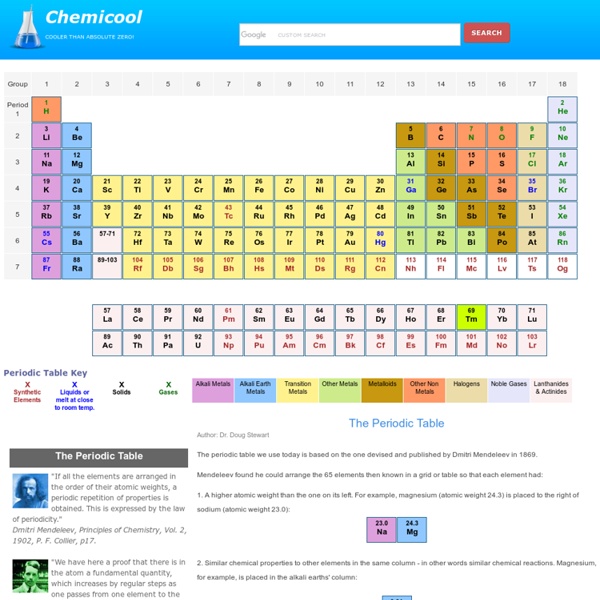



All Factors of a Number Go straight to Factors Calculator. There can be many factors of a number. Example: All the factors of 12 2 × 6 = 12, but also 3 × 4 = 12, and of course 1 × 12 = 12. So 1, 2, 3, 4, 6 and 12 are factors of 12. Classic ChemBalancer - Welcome This is the classic version of Chembalancer that teaches you how to balance equations for the first time. To play it, just press the "Start Game" button above. To play the other versions, click here. Electromagnetic Spectrum: Radio Waves Global rating average: 0.0 out of 50.00.00.00.00.0 These sites explain how radio waves are a part of the electromagnetic spectrum. Includes information about AM and FM frequencies and how to measure waves. Also includes a biography on Marconi, inventor of the radio. Includes several animated movies, hands-on activities and interactive quizzes.
Vehicle registration plates of the United Kingdom, Crown dependencies and overseas territories Vehicle registration plates are the mandatory number plates used to display the registration mark of a vehicle, and have existed in the United Kingdom since 1904. It is compulsory for most motor vehicles used on public roads to display them. The Motor Car Act 1903, which came into force on 1 January 1904, required all motor vehicles to be entered on an official vehicle register, and to carry number plates. The Act was passed in order that vehicles could be easily traced in the event of an accident or contravention of the law.
Chemical & Engineering News: What's That Stuff? You might ask yourself... What's That Stuff? Ever wondered about what's really in hair coloring, Silly Putty, Cheese Wiz, artificial snow, or self-tanners? C&EN presents a collection of articles that gives you a look at the chemistry behind a wide variety of everyday products.
Electricity: Circuits, Conductors, and Batteries Global rating average: 0.0 out of 50.00.00.00.00.0 These sites have lots of illustrations and animations that demonstrate how electricity, circuits, and batteries work. Learn the difference between conductors and insulators and the difference between series circuits and parallel circuits. Chemistry Review Activities I re-organized the course during the 2014 - 2015 school year. Some review activities were moved to new units. This has resulted in a change to some of the file names, so direct links to the individual activities may need to be changed. These are not graded assignments. They are intended only as practice of concepts and vocabulary that are essential to your success in this course. Most of these interactive review activities work equally well in recent versions of Internet Explorer, Firefox, Google Chrome, and Safari.
Strange Matter: Stuff for Teachers Download a Teacher's Guide Our teacher's guide is focused for grades 5 to 8. It includes background on the exhibition, pre- and post-visit hands-on activities using inexpensive, easy-to-find materials, teaching strategies, a glossary, resource lists and more. Download the Guide (At 1.4 MB, the guide will take about 4 minutes to download on a 56KB modem. chemsoc - for everyone interested in the chemical sciences We want everyone to experience the excitement and value of the chemical sciences. Our members and supporters reach out to connect people - from schoolchildren to scientists to political leaders - with chemistry. Whether you want to attend or run an event, set up a meeting or spend a few minutes writing an email, find out in this section how to get involved. Also in Campaigning & outreach: CampaigningFind out about our current campaigns and see how you can get involved in a way that suits you. PolicySee how we help to shape policy debates by providing expert information and leading the development of policy in key areas.
Atoms: Bonding You must first learn why atoms bond together. We use a concept called "Happy Atoms." We figure that most atoms want to be happy, just like you. The idea behind Happy Atoms is that atomic shells like to be full. That's it. If you are an atom and you have a shell, you want your shell to be full.
Top 10 Amazing Chemistry Videos Fiery explosions, beautiful reactions, and hilarious music videos are great reasons to be excited about chemistry. Here are some of our favorites. 10. Thermite vs. Molecular Workbench - An Interface to the Molecular World Three Views of MW Senior Scientist and Molecular Workbench Developer Charles Xie, Researcher and Manager Amy Pallant, and Technology and Curriculum Developer Dan Damelin describe the history of Molecular Workbench and our vision for the future. Watch the Video undefinedundefinedundefined
Chemistry Now The National Science Foundation (NSF) has joined forces with NBC Learn and the National Science Teachers Association (NSTA) to celebrate the International Year of Chemistry by creating "Chemistry Now"--a weekly, online video series that uncovers and explains the science of common, physical objects in our world and the changes they undergo every day. The series also looks at the lives and work of scientists on the frontiers of the 21st century... More. This video explains and illustrates the molecular structure of sodium chloride (NaCl) crystals; the structure and symmetry of crystal lattices; and why one crystalline solid, salt, melts another, ice. Global Carbon Footprints About this graphic Graphics by Stephen Rountree and Adam Marr Source: World Resources Institute CAIT 2.0 climate data explorer Emissions data and national boundaries are from 2010. For current emissions, per capita emissions, and intensity, the data are measured in tons of "carbon dioxide equivalent." That is, they include carbon dioxide and five other greenhouse gases (methane, nitrous oxides, hydrofluorocarbons, perfluorocarbons, and sulfur hexafluoride) as measured by their global warming potential. Cumulative emissions are measured in tons of carbon dioxide only. The emissions of Brazil and Indonesia may be understated because the numbers do not include calculations on land use change and forestry.